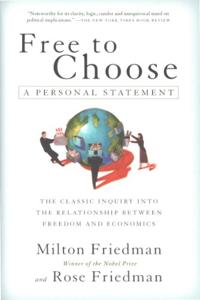
Want to learn the ideas in Free to Choose better than ever? Read the world’s #1 book summary of Free to Choose by Milton Friedman, Rose D. Friedman here.
Read a brief 1-Page Summary or watch video summaries curated by our expert team. Note: this book guide is not affiliated with or endorsed by the publisher or author, and we always encourage you to purchase and read the full book.
Video Summaries of Free to Choose
We’ve scoured the Internet for the very best videos on Free to Choose, from high-quality videos summaries to interviews or commentary by Milton Friedman, Rose D. Friedman.
1-Page Summary of Free to Choose
Overall Summary
The book Free to Choose is an attempt to answer questions about why government programs fail and how children can do better in school. It also explores the idea of paying more for goods and services while filling out forms, getting licenses, etc.
Milton Friedman is a Nobel Prize-winning economist who has many innovative ideas about economics. This book explains those ideas in simple terms, which can help fix many of the issues that plague modern governance.
The Friedmans believe that the increasing complexity and cost of our lives comes from government programs that are initially well intentioned but then grow out of control. The Friedmans provide historical evidence for their claim. They also argue why voters allow this to happen, which is because people have changed their minds about what government should do over time.
Chapters 1 and 2 explain how free markets work, and how government programs tend to hinder the smooth functioning of the marketplace. We learn that voluntary cooperation brings prosperity, while price distortions caused by side effects of government projects can hamper prosperity.
The book talks about how the Great Depression led to more government control over people’s lives, as a way of protecting them from bad events. The government then continued to grow over the years and took on new roles such as reducing inequality between rich and poor.
In Chapters 6-8, the Friedmans focus on specific government projects—schools, consumer protection and worker benefits—and how they exemplify the bloat and waste of programs that tend to enrich special interests. The solutions for these problems are also presented.
Inflation is a major problem in Chapter 9. It causes many problems and should be examined thoroughly. Finally, Chapter 10 proposes a limited government economic Bill of Rights that would have low inflation, flat taxes, and occupational freedom.
The book includes a short set of appendices, extensive footnotes, and a thorough index. It is written in straightforward prose easily accessible to the general reader. This book argues that freedom is better than government control and that people should be able to make their own decisions instead of being told what to do by bureaucrats or special interests.
Introduction
America has been a magnet for people who want to better their lives. This is based on the principles of prosperity through voluntary exchange as described by Adam Smith in The Wealth of Nations and Thomas Jefferson’s Declaration of Independence. John Stuart Mill believed that society can interfere with a person’s freedom only if it prevents harm to others.
America prospered after it was freed from the British rule. In fact, most of its citizens were farmers then while today only a few are. The shame of slavery was abolished and this led to agricultural growth in America which is now the largest food exporter in the world. In contrast, countries like Russia, India and China have large numbers working on farms but they still need food from other places since their own farms aren’t very productive.
Many believe that the abundance of liberty leads to a better government. They say that freedom can be used for more than just preserving freedom, but also cleaning up problems in society. The Great Depression was widely seen as a failure of free market capitalism and therefore led to an increased role by government in regulating commerce. Now, we have almost reversed Thomas Jefferson’s words: “That government is best which governs least.”
Well-intentioned government programs have not been effective in improving the welfare of citizens. Even supporters of these programs admit that their results have been disappointing. The failures occurred in major areas, including education, consumer protection, employment and inflation.





